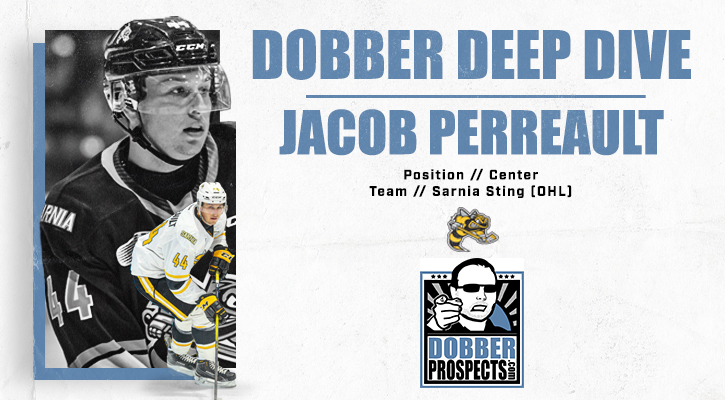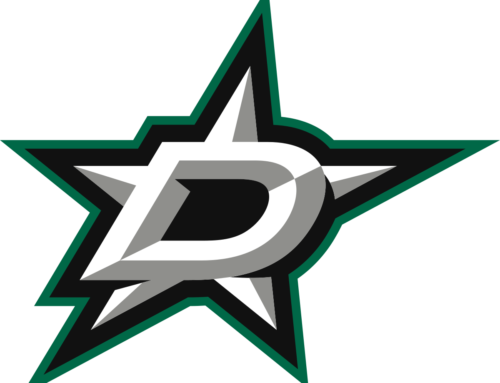Draft Class Deep Dive: RW Jacob Perreault
Tony Ferrari
2020-08-10

Image courtesy of Andrew Armstrong
Draft year is often the time we see junior-aged players take a jump and really start to contribute to their teams. The 2020 draft year is no exception with players like Jack Quinn taking a huge step in the production and Jake Sanderson going from second-round prospect to challenging Jamie Drysdale for the top defender in this class. The player that doesn’t seem to get the same kind of love for the improvements that he has made is Jacob Perreault of the Sarnia Sting. Going from a single tool offensive player who had some mobility issues to a well rounded offensive play driver who may have seen the biggest improvement of his raw tools of anyone in the class.
Possessing one of the best shots in the draft and improving leaps and bounds as a playmaker this year, Perreault has a real shot at becoming one of the premier dual-threat attackers coming out of this draft. Perreault was often the best player on the Sting at driving play and creating offense. He finished second on the team in scoring with 70 points in 57 games and found the back of the net 39 times, good for best on the squad. With Jamieson Rees only getting into 39 games due to injury and suspensions, Perreault was able to shoulder some of the load while growing as a player.

Jacob Perreault bio information courtesy of Elite Prospects.
There are certainly questions when it comes to where Perreault projects but if you examine his game and watch him at his best, you know that there is a chance that he could wind up being one of the top-10 players in the 2020 NHL Draft. The ceiling could be sky-high for an offensive player that continues to grow and mature as a player, seemingly improving on a week-by-week basis.
Growth and Mobility
The growth of Perreault’s game has been the driving force to his rise on some draft boards and the reason that some, in both NHL circles and the media, have argued that he has the raw talent to be a top-ten player in this years draft class, despite the loaded top-end of the 2020 class. While there is still a boatload of development for that statement to be true, the growth that the Sting forward showed this season over last was very impressive. Skating is often referred to as the base of the modern NHL. Skating is where Perreault took the biggest step.
In the following video from last season, Perreault pressures the Flint defenders and strips the puck from them, and makes his way up the ice on a breakaway. This gives us an excellent view of his skating mechanics and where he lacked as a skater. His stride is short and very light. While he does gather speed fairly quickly, it is very inefficient as he doesn’t have much power in his stride as he places each foot in a forward sliding placement in a pseudo-glide. While he does pull away, that has more to do with his quick feet than it does his skating mechanics. The ankle and knee flexion (bend) are okay but again, the lack of strength and power forces him to resort to a more gliding stride.
In comparison, we see a vast improvement in the mechanics of his skating and see him utilize skating various aspects of his improved technique such as crossovers and crisp edgework in our next clip. As he collects the loose puck in his own zone, Perreault tracks back behind his own net to survey the ice and gain some breathing room. Identifying the open ice in front of him, he turns on the jets to push up ice. As you can see from this clip, the power in his stride has greatly improved and his stride pushes him forward. He utilizes his edges effectively and even incorporates excellent stickhandling and a couple of head/shoulder fakes with footwork to match the deception. By no means a perfect skater, improvements like this lead one to believe that further growth in this area isn’t only possible, but expected.
Skating isn’t the only part of a player’s game that plays into their mobility. Skating paths, finding soft zones, and working their way around the ice all factor into how a player gets around the ice and how effective they are doing so. Perreault’s movement away from the puck is covert, allowing him to find space in the offensive zone. He is very subtle at times with his off-puck movement. Finding space and then jumping onto loose pucks is a strength of his. As we can see in the clip below, his ability to keep good spacing in the offensive zone is what leads to him being open in a good shooting position and scoring the goal.
Perreault often doesn’t get credit for his transition game. Still often perceived as a sub-par skater, he was not relied upon in a major way in his draft-1 season as a rookie in the OHL but with his emergence, this year as a player driving winger, his ability to generate breakouts and zone entries has come to the forefront in Sarnia. When looking at the data below, we can see that Perreault generates zone entries at a good rate but the strength of his entries comes in doing it with control. He outpaces many players who are likely going to draft ahead of him in terms of the rate of entries with control.

Transition data courtesy of InStat Hockey (BR = Breakouts, EN = Entries)
Overall, when comparing the Sting star to other draft-eligible players around the league, he is very comparable to Marco Rossi in terms of the raw numbers of generating breakouts and entries. Rossi, widely regarded as a sure-fire top-ten prospect, is a skilled and efficient player and while Perreault doesn’t have the same refinement in his game that Rossi is known for, he shows the ability to produce similarly in transition with his raw tools. Driving both entries and exits with control and push the play up ice is what integral to playing effective, top-six minutes at the NHL level. As we have looked at in videos up to this point, Perreault has become a much better player in transition with his improved skating.
Top-5 Scoring Talent
The 2020 NHL Draft features a variety of high-end finishers. From Alexander Holtz and Jack Quinn to Cole Perfetti and Quinton Byfield, there are several players with 30+ goal potential at the NHL level. Jacob Perreault is not only a top-five finisher, he’s likely better than at least a couple of those players when it comes to raw shooting talent. Outside of Alexander Holtz, he could have the best shot in the draft class. He has the ability to score from anywhere in the offensive zone because of his lethal release and scorching snap shot. He fires the puck from a variety of body positions and doesn’t need to be perfectly set up in a good shooting position.

Jacob Perreault shot chart, courtesy of InStat
He shoots with volume and he pushes into the faceoff circles regularly. As we can see in the graphic above, courtesy of InStat Hockey, we can see that the young Sting forward shoots from high and medium danger areas at a high rate and has the ability to score from just about anywhere in the offensive zone. We see that on the powerplay, Perreault largely generates shots from his half-wall position in and around the left faceoff circle. At even-strength, the shooting is much more diverse and spread out over the medium and high-danger areas.
As alluded to, Sarnia’s second-leading scorer doesn’t need to be in the perfect position to shoot the puck. Whether the one-time pass is slightly off or he has to alter his skating path on the rush, Perreault can shoot from unique and unorthodox angles and hand positions. In the next video, we get a look at his ability to take an inaccurate pass and still find a way to get the shot off. This level of shooting talent has NHL projectability due to its effectiveness and the room it leaves for error.
As can be seen in his shot chart, Perreault shoots from all over the offensive zone at even-strength. He scores in a variety of ways but because of his big shot, he often doesn’t get cited for his craftiness around the net. He has the ability to elevate in tight, using his body position to create space. As we continue the video study, we can see Perreault chase the loose puck behind the net. When his teammates are in a battle for the loose puck at the side of the net, Perreault is able to fish it out and gain control. Pivoting around and using that momentum to help add some pop to his shot from in tight.
On the powerplay, Perreault plays the half-wall more often than any other position on the powerplay but he has shown effectiveness around the net front and from the point. From the half-wall, he generates a ton of shots and has the ability to drive into high and medium danger areas with the open space. Perreault often works down to the side of the net from the half-wall because he has the ability to elevate from in-tight and the lightning-quick release to do so effectively. In the clip below, we see Perreault at the side of the net on a 4-on-3 powerplay. He remains on the goal line until the puck is on his stick. Once in possession, he moves slightly above the goal line and then roofs the puck on the Soo goaltender. Effortless release and pinpoint accuracy.
The backhand shot is a lost art. There are still some NHLers that use it regularly and effectively such as Patrick Kane and Sidney Crosby. Jacob Perreault could be the next name added to that list. Watching through all of Perreault’s goals from this season, he is certainly not afraid to use it and it might be the best backhander in the draft. Whether it’s putting it over a goalies shoulder on the breakaway or dashing down the wing on;y to surprise a netminder by beating them over the shoulder, the crowd in Sarnia has been blessed with some of the nicest backhand goals from the 2020 draft-eligible player. Below we see an example of Perreault’s backhand which
With the examples of the diverse arsenal of shots and various shooting locations provided so far, Perreault would be considered a crafty goalscorer who can work his way onto the scoresheet. His biggest tool is still his raw shot. Firing the puck from a set position or off the rush, the Canadian-American dual citizen is an intimidating force when he is involved in the offensive play. His shot is a threat from anywhere and everywhere in the offensive zone and only becomes more dangerous because of his ability to change angles or take shots from the unorthodox positions that we’ve touched on. In our next step in this video study, Perreault jumps onto the loose puck in the neutral zone and then immediately charges up ice. Once into the faceoff dot, Perreault decides to just grip it and rip it, even with a slight bobble.
The shooting talent that Perreault possesses is unreal. There is little doubt that he has the talent and raw ability to be one of the most lethal goal scorers in the class. The ability to score in a variety of ways with consistency makes him an even more dangerous player because if you take away the one-timer, he makes a move and gets into the middle. If you take away the middle, he has the puck skills and release to score from the side of the net with a quick shot. If you take away all three of those, he is a crafty playmaker as well.
Raw and Creative Passer
Perreault is known as a goal scorer and with good reason. Where he doesn’t get credit is the strides he made in his playmaking ability. With Perreault’s high level of skill, his effectiveness as a playmaker was bound to improve and it did this year. He is a problem solver who had to do solve a lot of problems as Sarnia was a bit of a lackluster team at times this season. While they did have some offensive pop from some of their veteran players, Perreault was often on a separate line from them, driving his own line, often with little help.
We’ll start where we left off when talking about his goal-scoring, on the powerplay. Perreault has very good vision. He sees his teammates all over the offensive zone and he shows very good spatial awareness. He moves all over the ice from his half-wall position. In the clip below, he corrals a bit of an errant pass and then turns towards the slot. Attacking with speed, the defense freezes and then moves towards Perreault. Once the passing lane opens Perreault is able to thread the needle on a beautiful pass across the seam.
One of the strengths of Perreault’s playmaking is his shot. With the constant threat of one of the best shots in junior hockey, Perreault forces defenses to account for him and panic when he gets open. In our next clip, we see Perreault playing in the CHL Top Prospects Game. With little chemistry due to limited practice and playing time, sometimes players struggle, specifically as a playmaker. In the clip below we see Perreault identify and then fade into space. He sets up for a one-timer all alone with about half the offensive zone to himself. When then pass comes to #44, he immediately identifies that the goaltender and defender are in motion, scrambling to get back into position. Perreault sends a one-touch pass to his linemate that the defender left alone on the backside. His vision and unselfish play provide the perfect foil to the booming shot that he possesses.
Perreault has underrated hands and has shown the ability to get around the offensive zone, flashing the skill to get by defenders and the strength to protect the puck. As a playmaker, he can stay aware of what’s going on around him and spot his teammates through traffic. He also has a tendency for passing from below the goal line. He likes to change levels and angles on his opponents and does it well. Below we see Sarnia’s leading goal scorer pick up the loose puck and head to the net. He’s forced below the goal line by a nice defensive play. Perreault protects the puck with his body and puck handling before pivoting and spinning to send a pass to the slot for his teammate. Passing from down low to the slot and changing the level of the goaltender and defender’s attention, he puts his teammate in a prime position to score.
While Perreault will likely always be a goal scorer first because of how good his shot is, his playmaking is crafty and creative. He uses his shot as a threat to draw defenders and keep the attention of goaltenders for that extra second needed to open a passing lane or spot a back door attacker. He likely would have had better assist totals if he was able to consistently play with the upper echelon players on the Sting but between injuries and the need to spread out the offense, Perreault was often tasked with driving his own line and he did that well on a sub-par team. He could be a sneaky dual-threat option in the 2020 NHL Draft.
Defensive Inconsistency
No one is going to tell you that Jacob Perreault’s defensive play is refined and the inconsistencies also do not help instill confidence. When he puts in an effort he is effective and forces decisions. There is some physicality to his game as well. He has a sturdy frame and he uses it from time to time, often surprising the opponent by just overpowering the opponent or even putting them on their butts. The positioning needs to be worked on and despite his listing at center on Elite Prospects, he will almost certainly play on the wing at the next level. His defensive play suits the responsibilities of a winger much better as well.
The defensive inconsistencies that plague Perreault range from game-to-game to shift-to-shift. Part of the reason that his defensive play may be ineffective at times is structure and effort. In the video above, the Sting are on the backcheck and Perreault is the second forward on the backcheck. Rather than applying some back pressure in the neutral zone, he pulls up a bit and trails the puck carrier. Applying a bit of backpressure could prevent a clean entry here and mitigate the need for in-zone defensive play. Once in the zone, there is a bit of wandering by the entire Sarnia unit. Perreault is no outlier. He doesn’t really seem to find any structure in the defensive zone, often playing ‘drive-by defense’ where he skates at the puck carrier and swipes at the puck a bit but doesn’t commit to engaging the puck carrier. He defaults the defending the slot towards the end of the clip but despite the fact that he is in a position to defend the high-danger area, he isn’t really committing to putting in the full effort needed defensively.
On the contrary, later in the same game, Perreault does exactly what he is expected to do in the previous clip. He is clearly skating harder on the backcheck. He stays engaged and applies backpressure as they enter the Sarnia zone. The stick taps and the constant annoyance of Perreault on the backcheck, although not high-intensity, is enough to disrupt the opposing attacker, leading to the player being bracketed by the Sarnia defenseman and being forced into the corner by Perreault and the Sarnia blueliner. This puts the attacker in a position to force a decision which results in a turnover and Perreault clearing the puck at the end of a long shift. When the effort is there, Perreault has the tools to be a good transitional defender.
Physicality is a tool that Perreault has that he doesn’t break out often but definitely has in the toolbox. He isn’t a hulking winger at 5’11”, but he is a strong player who has filled out his frame a bit as NHL Central Scouting has him listed at 192lbs. Perreault shows his strength when protecting the puck and holding off defenders but he also shows it when he leans on players in board battles or lays a hit. In the clip below, we get a glimpse at the physical side of his game. As he tracks back into the defensive zone, again applying a bit of backpressure. When the puck carrier stops up and turns to open up his view, Perreault follows through on a hit and then collects the puck and moves it up ice. While he doesn’t always utilize his physicality, he shows it often enough to know its a tool he possesses.
When he gets to the NHL level, Jacob Perreault will be an offense-first player. His shot, crafty playmaking, and high-octane offensive skill set should all translate to the NHL. His defensive game shows potential and as a scout, you look to see what a player’s flaws are and whether they can be improved upon or worked at. The defensive issues in Perreault’s game certainly seem like fixable traits like improving is motor or putting him into a bit more of a structured system, leading one to believe that even if he doesn’t become a defensive force, he can be an average defender who provides enough offensive value in the top-six to impact the game.
Swing for the Fences
Jacob Perreault is the kind of player that will need some development and still has an element of rawness to his game. The son of former NHLer Yanic Perreault should be an offensive contributor at the NHL level with the upside to break the 60-point plateau that his father never did, exceeding that if he can refine some of the finer points of his game. Understanding factors like body position and where his stick placement is in the defensive zone will go a long way to determining how prominent of a role he can take on at the NHL level.
His ceiling is that of a top-line winger, with the ability to dominate on the powerplay. His prowess with the puck on his stick in the offensive zone is only matched by the stealth of his off-puck movement. Perreault does an excellent job of finding soft spots and exploiting them. His shot is a constant threat that makes his playmaking all the more dangerous. With the improvements in his skating, strength, and playmaking, he could be the most underrated first-round prospect in the 2020 NHL Draft.
******
Thanks for joining me on this Draft Class Deep Dive! Be sure to check out the rest below and I also walked us through a thought experiment to explain why taking Quinton Byfield at #1 makes could make a ton of sense. Shot chart and statistics such as passing percentage and challenge rate courtesy of InStat Hockey, a top of the line video and scouting platform. For more from InStat, follow them on Twitter. For more on prospects and the NHL Draft, you can follow Tony Ferrari on Twitter.
For your fantasy hockey needs, the DobberProspects Fantasy Prospect Report and Fantasy Guide are the best sources to get you ahead of the game in your league whether you play in a simple year-to-year league or you’re involved in a decade long keeper league, the DobberProspects’ Fantasy Guides are your one-stop-shop for winning your league!
Draft Class Deep Dives






